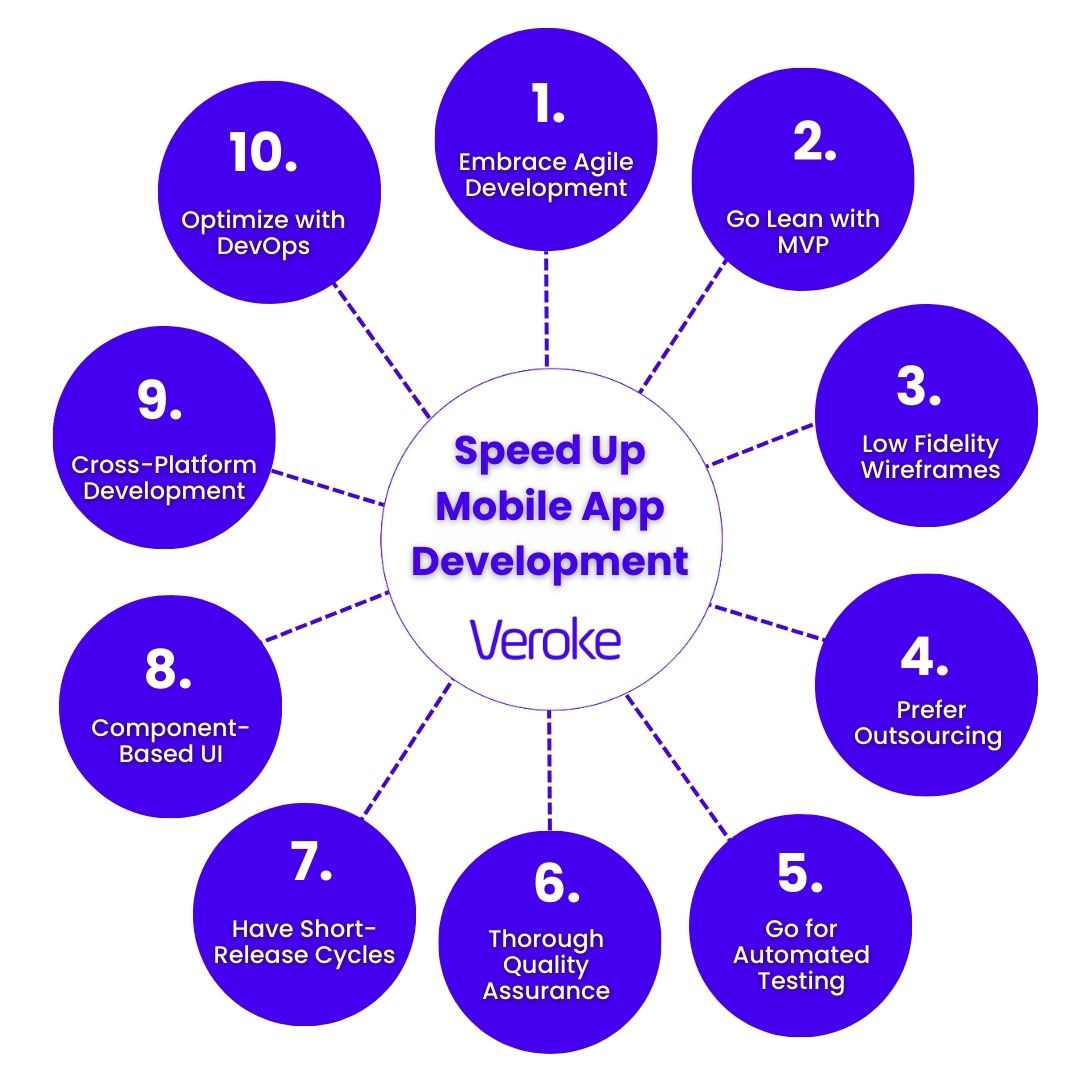Overview
Inside Saudi’s Tech Transformation
Get exclusive weekly insights into how the Kingdom is powering Vision 2030.
TL;DR
- Speed matters in mobile app development – launching faster helps capture market share, gather feedback, and refine your product early.
- Strategies like Agile development, MVP approach, automated testing, and component-based UI can drastically reduce timelines without sacrificing quality.
- Outsourcing and cross-platform tools streamline development, lower costs, and ensure faster delivery.
- Generative AI (GenAI) accelerates every stage, from wireframing and coding to testing and API integration, making app creation smarter and more efficient.
- Veroke, with 15+ years of experience, helps businesses launch high-quality apps faster through tailored, scalable, and innovation-driven development solutions.
Did you know the average person spends 4.9 hours a day on their phone – and 89% of that time is spent using mobile apps?
In today’s app-driven world, businesses that fail to launch fast risk falling behind competitors who are already capturing user attention and market share.
Time is money, especially in a market flooded with competitors where almost everything is available at the click of an app. With this fierce competition, the race to launch a mobile app has never been more intense.
As a business owner or entrepreneur, you understand the importance of bringing your app to market quickly, but you’re also aware of the risks associated with cutting corners.
Mobile app development is known for its lengthy development cycles, leaving companies and their owners searching for ways to speed up mobile app development without sacrificing quality.
But how do you speed up development without compromising quality and other key factors? At Veroke, we understand why this is a major concern or requirement of a service seeker who wants to create an app and take an edge in the market.
After all, the faster you can launch, the quicker you can capture market share, gather user feedback, and refine your product accordingly.
With over 15 years of experience in developing software and mobile apps, we have established ourselves as a trusted partner for our clients. They rely on us not only to maintain the high-quality standards that are our hallmark but also to exceed their expectations by delivering faster time-to-market solutions.
That’s why we’ve decided to share our insights on how we do it. In this blog post, we’ll discuss the practical strategies we use to shorten the app development timeline.
Whether you’re a startup aiming to make a quick impact or an established enterprise looking to optimize your development pipeline, these strategies will set you on the path to success.
Here are the 10 Ways to Speed Up Mobile App Development:

1. Embrace Agile Development
Agile development is centered around delivering high-quality products in the shortest time possible. Unlike traditional methods like Waterfall, it fosters flexibility and collaboration, allowing teams to adapt quickly to changes. By focusing on frequent communication between developers and clients, Agile ensures that the product evolves according to customer needs, ultimately speeding up the development process.
Agile development operates by breaking down the project into smaller, manageable tasks known as “sprints.” Each sprint is designed to deliver incremental improvements, making it easier to identify and fix issues early on. This approach reduces the time and cost associated with troubleshooting, making sure that the development process remains efficient and aligned with the project goals.
By doing so, you speed up development and continuously refine your product based on real-time feedback, all while maintaining your quality standards.
2. Go Lean with MVP (Minimum Viable Product)
To speed up mobile app development, we suggest going lean with a Minimum Viable Product. An MVP focuses on creating a simplified version of the app with essential features, allowing you to test the product in the market and attract early adopters. This approach significantly reduces development time, enabling you to launch the app faster and gather valuable user feedback.
The MVP process operates on small, iterative cycles, where new features are introduced and tested every few weeks. This build-measure-learn loop ensures that the app’s design and functionality evolve based on real-world feedback, allowing for continuous improvement. By focusing on core functionalities first, you can meet market demands swiftly while planning future enhancements based on user insights.
Instead of waiting for a fully-featured app, launching an MVP allows you to enter the market sooner and start gaining traction. This strategy not only speeds up development but also helps in refining the product to better align with customer expectations.
3. Utilize Low Fidelity Wireframes
To streamline the app development process, using low-fidelity wireframes can be a great strategy for you. Unlike high-fidelity wireframes, which are detailed and time-consuming, low-fidelity wireframes offer a basic blueprint of the app’s structure.
These abstract representations help developers and designers quickly align on the app’s layout and functionalities, saving valuable time in the initial stages of development. Wireframes act as the foundational step in the development process, bringing everyone on the team onto the same page.
By outlining the app’s core functionalities and user flow early on, low-fidelity wireframes facilitate parallel development and design work. This synchronization not only accelerates the process but also reduces the chances of miscommunication or errors later in the project.
We find that wireframing is an essential step that unifies the entire team under a common vision. You can do the same by using wireframes to bring everyone on the same page, ensuring that development and design work in parallel.
4. Prefer Outsourcing
Outsourcing is a practical solution if you’re looking to accelerate development. By delegating specific aspects or the complex stuff of the project to external experts, you can free up your in-house team to focus on core functionalities. For instance, if your team excels in iOS development, outsourcing the Android version can save significant time and resources, allowing both versions to progress simultaneously.
Outsourcing also proves to be a cost-effective strategy. Hiring a specialized team can be more economical than stretching your in-house resources thin. For complex projects that require specialized skills, outsourcing ensures that the development process is handled by experts who are well-versed in the latest industry practices, leading to quicker and more efficient results.
Moreover, an outsourced team brings a wealth of experience to the table, often having worked on similar projects before. This familiarity with best practices and potential pitfalls allows them to navigate the development process more swiftly, reducing the time spent on trial and error. By leveraging outsourcing, you can accelerate your app’s time to market without compromising on quality.
5. Go for Automated Testing
Automated testing is another powerful strategy. By automating the testing process, you can run multiple tests simultaneously, which drastically reduces the time required for manual testing. This not only speeds up the development cycle but also ensures that the app is thoroughly tested.
Using automated testing tools allows developers to conduct comprehensive tests with minimal human intervention. These tools can run a full suite of tests in a fraction of the time it would take manually, enabling faster identification and resolution of issues. This efficiency is particularly crucial for complex apps that require rigorous testing to meet high-quality standards.
Automated testing also contributes to maintaining a high level of consistency and accuracy throughout the development process. By incorporating automated tests into your workflow, you can ensure that each new feature or update is tested against the same criteria, reducing the risk of errors.
6. Thorough Quality Assurance
Thorough Quality Assurance (QA) is essential for delivering a robust mobile app. This approach allows us to identify and address issues early, reducing the time and effort required for bug fixes and ensuring a smoother overall development experience.
During our QA sessions, we rigorously test the app’s usability and functionality to ensure it meets both performance standards and user expectations. Our dedicated team of QA Analysts collaborates closely with the design and development teams to bridge any gaps between client requirements and the final product.
This ongoing communication helps maintain alignment and high quality throughout the development cycle. Effective QA not only detects bugs but also improves the app’s performance and user-friendliness.
7. Have Short-Release Cycles
Adopting short-release cycles can significantly enhance the speed of app development. By delivering updates and new features on a weekly or even more frequent basis, you minimize the risk of errors and foster continuous delivery. This approach accelerates the development process by allowing for rapid iterations and timely feedback.
To achieve short-release cycles, we follow these three key steps:
- Identifying the MVP
- Automating testing and deployment
- Releasing to a pilot group for feedback
This strategy ensures that each iteration is refined and aligned with user needs, speeding up the overall development timeline and improving the product’s quality. Frequent releases allow for quick assessment of feature performance among a select group of users, providing valuable insights for further development.
8. Component-Based UI
Implementing a component-based UI is a strategic approach to speed up mobile app development. This method involves creating reusable components that can be shared across different apps or within different parts of the same app. By developing a sustainable technical framework, you save time and reduce costs associated with building unique elements from scratch.
Component-based UI design enables efficient development by reusing code snippets for common functionalities such as login features or social media sharing. The ability to reuse well-tested components reduces the likelihood of bugs and enhances overall development efficiency.
While each project may have unique requirements, leveraging reusable components helps streamline the development process. By incorporating pre-built elements, you can focus on customizing the app’s specific features and user experience, ultimately delivering a high-quality product more quickly.
9. Cross-Platform Tools (Hybrid Mobile Development)
In mobile app development, choosing which platforms to support can be a challenging decision. Developing separate apps for each platform often leads to increased development time and costs, as well as complex maintenance.
Fortunately, cross-platform tools offer a streamlined solution. By enabling you to build and maintain one codebase that works across multiple platforms, these tools significantly cut down on development time and effort. Technologies like React Native, Adobe PhoneGap, and Xamarin make it possible to deploy your app on both iOS and Android from a single codebase.
This approach not only accelerates the development process but also ensures consistency across different devices. Cross-platform development helps you reach a broader audience more efficiently, reducing the need for repetitive coding and speeding up your app’s time to market.
10. Optimize with DevOps
DevOps plays a crucial role in speeding up mobile app development by integrating specialized tools and practices that enhance efficiency. By fostering a collaborative environment between development and operations teams, DevOps methodologies streamline the development process and accelerate software delivery.
Tools like Android Studio, which includes the Gradle build system for automated asset bundling and app package creation, contribute to faster development cycles. Additionally, the Emulator allows for quick testing on virtual devices, while the ML Kit simplifies the integration of advanced features such as machine learning and AI.
GitHub is another valuable tool for version control, remote file sharing, and project backup. By leveraging these DevOps tools, teams can achieve greater efficiency and faster time-to-market. Effective DevOps execution requires clear role definitions and communication channels, which facilitate close monitoring and feedback, further enhancing development speed and quality.
Bonus tip: Speed Up Mobile App Development with GenAI
If you’re still looking for an easy way to accelerate your mobile app development? Generative AI (GenAI) might be your solution! Here’s a bonus tip to help you streamline your process.
Mobile app development is a complex process that demands meticulous planning, execution, and testing. However, with GenAI, this process becomes simpler and faster, revolutionizing the way we build applications.
How GenAI Accelerates Mobile App Development?
GenAI eliminates the need for deep technical expertise, making app development more efficient and enhancing the user experience. From personalizing user journeys to crafting wireframes, GenAI allows you to design intuitive mobile apps and transform them into real products swiftly.
In essence, GenAI helps you streamline and accelerate mobile app development, allowing you to launch your app ahead of competitors and capture the market faster.
Here are 5 ways GenAI speeds up mobile app development:
➤ User Persona Generation
Before diving into app design, understanding your users is crucial. GenAI helps by collecting user insights to create detailed personas. These personas, in turn, lead to the development of user stories and scenarios, guiding you towards a user-centered design. By automating this process, GenAI saves time and ensures you have accurate user personas to define app features effectively.
➤ Code Generation and Prototyping
AI-powered tools accelerate mobile app development by auto-completing code and suggesting algorithms. GenAI handles routine tasks like backend connections and authentication screens, providing ready-to-use code. However, experienced developers are essential to integrate and test the code for a fully functional app. Tools like GitHub Copilot and ChatGPT are invaluable for this process.
➤ Wireframing and UI/UX Mockups
As we discussed earlier, wireframing is the foundation of app design, illustrating screens and their components. GenAI assists in brainstorming and generating initial wireframes, which can be refined to match user needs. By leveraging GenAI plugins in tools like Figma, you can rapidly create and iterate on design layouts, ensuring they align with user stories and scenarios for a seamless user experience.
➤ Testing and Feedback Loops
Automated testing ensures your app works on all devices and OS versions. AI-powered tools like Testim adapt to changes and maintain test accuracy. Additionally, GenAI can generate unit tests, though manual oversight is necessary for complex algorithms. Tools like Lumoa analyze user feedback, offering insights and improvement suggestions, ensuring your app evolves with user needs.
➤ API Integration and Automation
AI tools like OpenAI can be easily integrated into your application through API calls, making the process more streamlined. These APIs enable real-time features like chatbots and voice assistants, enhancing user interaction and automating tasks. Businesses can leverage these capabilities to improve customer service and streamline operations.
Conclusion
In a nutshell, speed is essential in mobile app development, but it should never affect the quality. Strategies like developing a Minimum Viable Product (MVP), using low-fidelity wireframes, embracing agile methodologies, and incorporating automated testing can significantly accelerate the development process without compromising on quality.
However, ensuring that your app is thoroughly tested and meets high standards is essential for long-term success. Also, Generative AI offers valuable support in enhancing development efficiency, but human expertise remains crucial for eliminating biases and ensuring precision.
Striking the right balance between leveraging advanced AI tools and maintaining expert oversight is key to delivering a successful mobile app.
Looking to bring your mobile app to life quickly and efficiently? We’re here to guide you every step of the way. Contact us today to discuss your vision, and together, we’ll craft a timeline that ensures your app hits the market with speed and precision. Your next successful app is just a tap away—let’s make it happen!
FAQs
1. How to speed up mobile development?
To speed up the development, focus on developing core features first to create a Minimum Viable Product (MVP). This strategy allows you to launch faster, gather user feedback, and make iterative improvements, reducing the time to market.
2. How long should it take to develop a mobile app?
Development time varies based on complexity and features:
- Basic App: 2-3 months
- Average App: 3-5 months
- Complex App: 6+ months
Factors such as the app’s complexity, design, and chosen development partner can influence these timelines.
3. How can I improve my app speed?
You can improve speed by implementing efficient coding practices, leveraging caching techniques, enhancing server response times, adopting modern technologies, and conducting regular performance testing.
Want to know more about our service.
Inside Saudi’s Tech Transformation
Get exclusive weekly insights into how the Kingdom is powering Vision 2030.
Transform your Ideas into a Digital Reality
Get scalable, customized solutions for your business.




